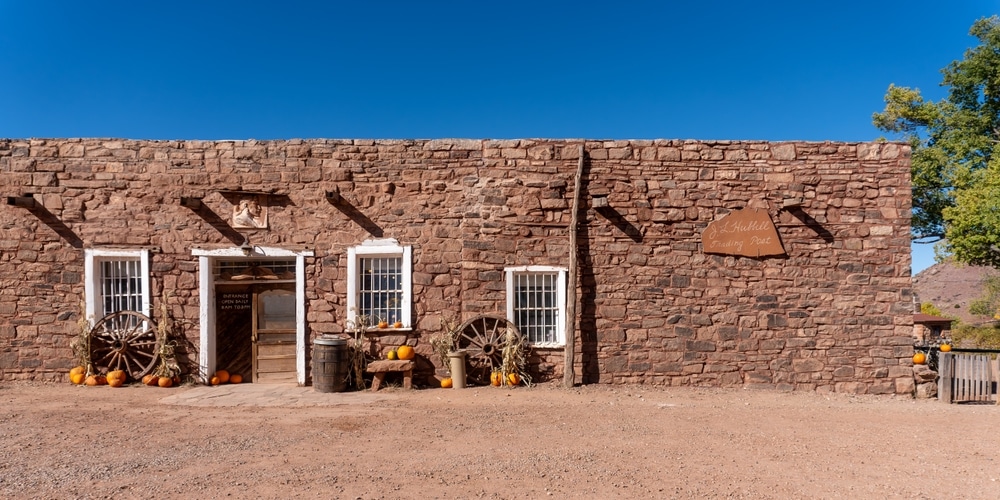Nestled in the heart of the Navajo Nation in northeastern Arizona, Hubbell Trading Post National Historic Site stands as a living testament to the rich cultural exchange that shaped the American Southwest. Established in 1878 by John Lorenzo Hubbell, this trading post remains the oldest continuously operating trading post on the Navajo Nation, bridging past and present through authentic trade and cultural preservation. Unlike many historical sites that merely preserve artifacts behind glass, Hubbell Trading Post continues to function as it has for more than 140 years—as a vibrant center of commerce and cultural interaction.
The trading post’s adobe buildings and wooden plank floors have witnessed generations of exchanges between Navajo artisans and traders, creating a unique intersection of Native American and Anglo-American cultures. As part of Arizona’s diverse tapestry of federal and public recreational lands, Hubbell Trading Post offers visitors a rare glimpse into a living history that continues to evolve while honoring traditional ways of life.
Designated as a National Historic Site in 1967, the 160-acre property is now managed by the National Park Service, which works in partnership with the nonprofit Western National Parks Association to maintain the trading post’s authentic operations. This partnership ensures that the site serves not only as a window into history but also as a continued source of economic opportunity for local Navajo artisans and a place for cultural understanding and appreciation.

The centerpiece of the site is the original trading post, where you can step back in time and experience the atmosphere of a 19th-century frontier store. The trading post is still active, selling a variety of items such as:
The trading post is a living museum where commerce and culture continue to thrive.
Hubbell Trading Post is a great place to purchase authentic Navajo art directly from the source. The rugs, jewelry, and crafts sold here are handmade by local artisans, ensuring quality and supporting the Navajo community. The trading post’s rug room is particularly famous, showcasing an impressive collection of Navajo weavings in a variety of styles and patterns.

Adjacent to the trading post is the Hubbell family home, a historic adobe structure built in the late 1800s. Guided tours of the home provide insight into the life of John Hubbell and his family, as well as their relationships with the Navajo people. Inside, you’ll find:
The home reflects the blending of cultures and the Hubbell family’s dedication to supporting and preserving Navajo traditions.

Hubbell Trading Post is an excellent place to immerse yourself in Navajo culture. The site regularly hosts demonstrations and events featuring local artists and craftsmen. You can watch Navajo weavers create their famous rugs or silversmiths craft intricate jewelry. These activities provide a deeper understanding of the artistry and cultural significance behind these traditional crafts.

The historic trading post, surrounding landscapes, and traditional Navajo crafts provide endless opportunities for photography. Capture:

Hubbell Trading Post is located in the heart of Navajo Nation, making it a great stop on a broader exploration of the area. Nearby attractions include:

| Category | Details |
|---|---|
| Location | Ganado, Arizona, on the Navajo Nation |
| Established | August 28, 1965 |
| Managed By | National Park Service |
| Size | Approximately 160 acres (65 hectares) |
| Main Attractions | Historic trading post, Hubbell family home, visitor center, and sheep corrals |
| Historical Significance | The oldest continuously operating trading post on the Navajo Nation, established in 1878 by John Lorenzo Hubbell |
| Cultural Significance | A center for trading Navajo rugs, jewelry, pottery, and other Native American crafts, preserving Navajo culture and traditions |
| Recreation Activities | Guided tours of the Hubbell home, shopping for Native American art, and self-guided exploration of the grounds |
| Nearby Landmarks | Canyon de Chelly National Monument, Petrified Forest National Park, and Window Rock |
| Ecosystem | High desert grasslands with piñon pines, junipers, and sagebrush |
| Wildlife | Includes birds, small mammals, and reptiles native to the desert ecosystem |
| Visitor Center | Features interpretive exhibits, a bookstore, and information about the trading post’s history |
| Accessibility | Visitor center and parts of the trading post are wheelchair accessible |
| Fun Fact | Hubbell Trading Post still operates as a working trading post, where visitors can purchase authentic Navajo rugs and crafts directly from local artisans. |
John Lorenzo Hubbell, a Spanish-American who became fluent in the Navajo language, established his trading post at a critical time in Navajo history. Following the devastating Long Walk of 1864-1868—when thousands of Navajo people were forcibly relocated to Bosque Redondo in New Mexico before being allowed to return to a portion of their homeland—the tribe was rebuilding their lives and economy. Hubbell, through fair trading practices and genuine respect for Navajo culture, became a trusted figure who helped facilitate economic recovery through trade.
Over time, Hubbell and his family became influential advocates for Navajo artisans, encouraging the production of high-quality rugs, jewelry, and other crafts that would appeal to distant markets. The Hubbell family’s appreciation for Navajo craftsmanship helped preserve and promote these art forms during a time of tremendous cultural pressure and change.
Hubbell Trading Post exemplifies the trading post system that became the economic backbone of the Southwest from the late 19th through mid-20th centuries. Trading posts served as essential commercial hubs where Native Americans could exchange wool, livestock, handcrafted items, and eventually rugs and jewelry for manufactured goods, food staples, and tools. They functioned as post offices, news centers, and social gathering places for isolated communities.
What sets Hubbell apart is its remarkable continuity—the trading traditions established by John Lorenzo Hubbell continue today, adapting to changing times while maintaining the core practices that have defined the post for generations. This continuity provides an authentic window into a significant chapter of American economic and cultural history that shaped the Southwest.
Walking into Hubbell Trading Post feels like stepping back in time while remaining firmly in the present. The bullpen—the central trading area named for the wooden fence-like counter that separates customers from the store’s goods—remains the heart of the operation. Here, visitors can observe actual trading taking place and purchase a variety of items, from basic groceries and hardware that serve the local community to authentic Native American arts and crafts.
The post’s shelves and display cases showcase exquisite Navajo rugs and textiles, handcrafted silver and turquoise jewelry, baskets, pottery, and other traditional and contemporary Native American art. Unlike souvenir shops with mass-produced items, the trading post carefully sources its merchandise, with a focus on authentic, locally-made crafts that support Native American artisans.
Visitors can witness the continuation of traditional trading practices, including rug authentication and valuation. Navajo weavers still bring their rugs to the trading post for sale, where knowledgeable staff examine each piece for quality, design, and workmanship before negotiating a fair price—a practice that has continued for generations.
Adjacent to the trading post stands the Hubbell family home, a sprawling adobe structure that showcases the family’s unique position at the cultural crossroads. Tours of the home reveal a fascinating blend of Victorian furnishings, Southwestern architecture, and one of the largest collections of Native American art acquired by a single family. The home contains over 300 Navajo rugs, original paintings by early Southwestern artists, pottery from various Puebloan cultures, and numerous Native American baskets and ceremonial items.
The home’s design itself reflects this cultural fusion, with thick adobe walls following traditional building techniques of the Southwest, interior rooms arranged in a classic American Victorian pattern, and decor that showcases both Anglo and Native American aesthetic sensibilities. The property’s barn, bunkhouse, guest hogan, manager’s residence, and bread oven (horno) complete the historic complex, offering a comprehensive view of life at this cultural intersection.
One of the most engaging aspects of visiting Hubbell Trading Post is the opportunity to witness artisans at work. The site regularly hosts cultural demonstrations where visitors can observe traditional Navajo rug weaving, silversmithing, basket making, and other traditional crafts. These demonstrations provide not just entertainment but education about the complex techniques, cultural significance, and continuing evolution of these art forms.
Artisans share their knowledge about natural dyes, traditional designs, and the meaning behind different patterns and symbols, creating a deeper appreciation for the items available for purchase in the trading post. These interactions foster cultural understanding and help sustain traditional knowledge by creating economic opportunities for artisans practicing traditional crafts.
Beyond the trading post and historic home, Hubbell Trading Post includes a still-functioning ranch that adds another dimension to the visitor experience. The site maintains a small herd of Churro sheep—the traditional livestock of the Navajo people—along with horses and other farm animals that would have been part of the original trading post operation.
Visitors can explore the grounds to see the historic barn, corrals, and farming equipment that illustrate the agricultural aspects of trading post life. Seasonal activities on the ranch, including sheep shearing, provide additional insights into the wool trade that formed a cornerstone of the regional economy.
The ranch also features heritage gardens where traditional crops are grown using historic farming techniques. These gardens showcase the adaptation of agriculture to the high desert environment and the blending of Native American and European farming traditions that characterized subsistence in this challenging landscape.
Hubbell Trading Post sits at approximately 6,300 feet elevation in the high desert plateau of the Colorado Plateau. The site offers beautiful views of the surrounding landscape, including the distant Chuska Mountains to the north and the red rock formations characteristic of the region. The trading post is situated along Pueblo Colorado Wash, a seasonal stream that provided essential water for the ranch operations.
The grounds include short walking trails that allow visitors to experience the natural environment that shaped life at the trading post. Interpretive signs along these paths explain the ecology of the region, traditional Navajo uses of native plants, and the challenges of sustaining life in this arid environment.
Visitors might spot wildlife including jackrabbits, desert cottontails, coyotes, and a variety of birds native to the high desert. The landscape demonstrates the resilience required of those who made their lives in this beautiful but demanding environment, offering context for understanding the trading economy that developed here.
The National Park Service offers various educational programs at Hubbell Trading Post that enrich the visitor experience. Ranger-led talks explore topics ranging from trading post history to Navajo culture, the wool economy, and environmental adaptations to the high desert environment.
School groups benefit from specialized educational programs that align with curriculum standards while providing hands-on experiences with history and cultural exchange. The trading post participates in the National Park Service’s Junior Ranger program, offering activities designed to engage younger visitors in exploring the site’s historical significance and cultural context.
For those seeking deeper understanding, the Western National Parks Association maintains a bookstore with a curated selection of publications about trading post history, Navajo culture and art, and the broader history of the American Southwest.
Hubbell Trading Post National Historic Site is located in Ganado, Arizona, approximately 55 miles northwest of Gallup, New Mexico, and about 90 miles northeast of Flagstaff, Arizona. The site is accessible via Arizona Highway 264, a scenic route that traverses the heart of the Navajo Nation.
The trading post is open year-round, though hours vary seasonally. The site charges a modest entrance fee, which is waived for holders of National Park Service passes. As a federal site on tribal land, Hubbell Trading Post operates within both National Park Service guidelines and with respect for Navajo Nation protocols.
The visitor center provides orientation materials, exhibits on trading post history, and information about daily tours and demonstrations. Restroom facilities, picnic areas, and a parking lot accommodate visitors’ basic needs. Much of the site, including the trading post itself and portions of the grounds, is wheelchair accessible, though the historic nature of some buildings means that accessibility is limited in certain areas.
Visitors should be aware that they are guests not only at a historical site but within the Navajo Nation. Respect for cultural practices is essential—photography restrictions apply in certain areas, particularly during cultural demonstrations, and should always be approached with sensitivity. Navajo people may have different cultural norms regarding eye contact, conversation, and personal space that visitors should respect.
When purchasing Native American arts and crafts, visitors support not only individual artisans but the continuation of cultural traditions. Staff can provide information about the significance of different designs and materials, enhancing appreciation for these art forms.
The high desert location means that Hubbell Trading Post experiences significant temperature variations. Summer days can be quite hot, while winters bring cold temperatures and occasional snow. Spring and fall offer the most moderate weather, though spring can bring strong winds. Visitors should check weather forecasts before visiting and dress in layers to accommodate changing conditions throughout the day.
Cultural demonstrations and special events occur more frequently during the summer tourist season, but visiting during the quieter winter months offers a more contemplative experience and the opportunity to see the trading post as many local customers do—as a community institution rather than primarily as a tourist destination.
Hubbell Trading Post provides a cultural and historical complement to the predominantly natural attractions that dominate Arizona’s public lands. Visitors exploring the famous landscapes of Arizona’s national parks and monuments can enrich their understanding of the human history of the region through a visit to this living historical site.
The trading post is relatively close to several other significant sites, including Canyon de Chelly National Monument, Petrified Forest National Park, and the Painted Desert. Travelers can incorporate Hubbell Trading Post into a broader itinerary exploring the natural and cultural heritage of northeastern Arizona and the Navajo Nation.
For those interested in Native American culture, Hubbell Trading Post offers an authentic experience that provides context for understanding the arts, crafts, and cultural items encountered throughout Arizona. The site’s continuing function as an actual trading post differentiates it from museum-like presentations at many other historical sites.
The National Park Service faces unique challenges in preserving Hubbell Trading Post as both a historical site and a functioning business. Conservation efforts must balance historical authenticity with practical functionality, ensuring that buildings and artifacts are preserved while the trading post continues its commercial operations.
The partnership between the National Park Service and the Western National Parks Association represents an innovative approach to managing a living historical site. This collaboration allows for the continuation of trading practices while ensuring proper stewardship of the historical resources.
Visitors can support conservation efforts through responsible visitation, learning about the site’s significance, and purchasing authentic Native American arts and crafts that help sustain traditional cultural practices. By appreciating the complex cultural exchange represented at Hubbell Trading Post, visitors contribute to the ongoing dialogue about the preservation of living historical sites and traditional lifeways.
Hubbell Trading Post National Historic Site offers a unique window into the complex cultural interactions that shaped the American Southwest. Unlike many historical sites that simply preserve the past, this living trading post continues the traditions established by John Lorenzo Hubbell nearly 150 years ago, adapting to changing times while maintaining authentic connections to traditional practices.
For visitors to Arizona’s public lands, Hubbell Trading Post provides essential human context for understanding the broader landscape. Here, in the continued exchange of goods and cultural perspectives, we can witness history not as a static relic but as an ongoing process that shapes communities and individuals. The posts’ wooden floors, worn smooth by generations of traders and customers, remind us that history is not merely something that happened in the past but something we continue to create through our interactions and exchanges.
In an age of increasingly homogenized commercial experiences, Hubbell Trading Post stands as a reminder of the value of authentic human connections, cultural understanding, and respect for traditional knowledge. As both a recreational destination and a place of living history, it exemplifies the diverse values represented in Arizona’s federal and public lands—cultural heritage, education, commerce, and the preservation of traditional lifeways for future generations.
We use cookies to improve your experience on our site. By using our site, you consent to cookies.
Manage your cookie preferences below:
Essential cookies enable basic functions and are necessary for the proper function of the website.
Statistics cookies collect information anonymously. This information helps us understand how visitors use our website.
Marketing cookies are used to follow visitors to websites. The intention is to show ads that are relevant and engaging to the individual user.